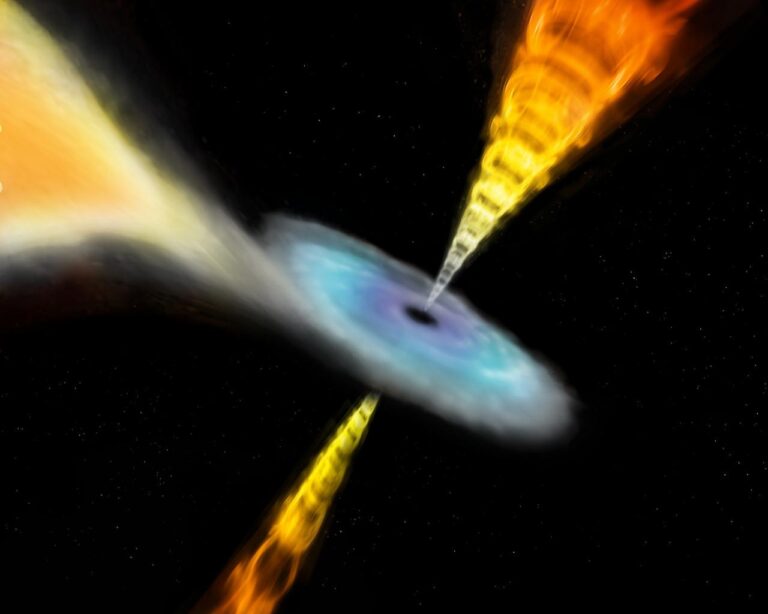At the extremes of mass, energy, gravity and space-time – black holes still present a mystery for scientists, yet the key to finding a way forward is reconciling gravity, described by Albert Einstein’s general relativity, and the behaviour of subatomic particles modelled using so-called quantum theory.
Researchers are using quantum theories to better understand the behaviour of black holes such as the GX 339-4 binary system. Artist’s impression courtesy of ESA/ATG medialab
The recent announcement of the detection of waves in the fabric of space thrown out by colliding black holes has thrust these mysterious phenomena into the headlines. But while the observation confirms a 100-year-old prediction by Einstein, many mysteries still swirl around black holes and how the physics of the incomprehensibly large meets that of the unimaginably small.
A thorough understanding of the effects of gravity at a subatomic level – known as quantum gravity – is not yet in grasp, but achieving it would help to solve mysteries about the beginning of the universe and the fundamental nature of matter, energy and even time.
One approach physicists and astrophysicists have been pursuing is that of string theory, a mathematical way of thinking about elementary particles as manifestations of tiny vibrating one-dimensional strings.
‘String theory can be considered to be a consistent framework for quantum gravity,’ said Dieter Lüst, professor of mathematical physics at Ludwig Maximilian University of Munich in Germany. ‘But we still need to understand how black holes contain string theory, and what their quantum properties are.’
Prof. Lüst’s STRINGS&GRAVITY project, funded by the EU’s European Research Council, is using string theory to explore extending gravity to the microscopic level – beyond the realms of what Einstein’s theory of general relativity covers – to quantum gravity and its role in the formation of black holes.
Among the project tasks is computing the likelihood of observing the effects of string theory, which includes extra dimensions, when using very high energies in the Large Hadron Collider at CERN. That could be a path to understanding the quantum effects involved in the possible formation of mini black holes.
Prof. Lüst also aims to find ways in which string theory is able to explain properties of the early universe, as well as concepts such as quantum information – details of properties such as the spin of subatomic particles.
Universal quantum computer
Of particular interest is how black holes store information, if it is not destroyed by the extreme conditions.
‘So an interesting concept is how quantum information is encoded in black holes,’ he said. ‘It is possible to view black holes as a kind of universal quantum computer.’
‘We sort of lose a dimension, in some sense.’
Dr Troels Harmark, associate professor of theoretical physics at the Niels Bohr Institute of the University of Copenhagen, Denmark, has been developing a new, specific quantum mechanical theory – Spin Matrix theory – which he is using to explore the interface between gravity and quantum theory.
‘In general, finding out how to get out gravity from quantum theory is very, very difficult, and nobody knows how to do it at this point,’ said Dr Harmark, who is doing the work as part of the EU-supported QUNAT project.
‘So I am trying to take a particular case, which is simple enough that I can actually say something quantitative about how it works, but complicated enough that there is an interesting gravitational theory coming out of it,’ he said.
Success would mean a step forward in understanding the quantum properties of black holes, as well as in the study of gravity itself.
Holographic principle
Among the concepts he employs is the ‘holographic principle’, where the entropy of a black hole – the amount of disorder – is proportional to its surface area. Since entropy is related to the information contained by a black hole, this points to the idea that all the information associated with a black hole is contained on its surface, or event horizon.
The idea is analogous to looking at a hologram on a bank card. The information of a three-dimensional object is contained in a two-dimensional surface, so one dimension effectively disappears.
Going from our normal perspective of everyday energies and distances, to looking at very high energies and small distances, is like switching from one side of this duality to the other.
‘If you start at the gravitational side of the duality, which could be like our four-dimensional universe and then you go to a quantum side, there you suddenly only have three dimensions. So we sort of lose a dimension, in some sense,’ Dr Harmark said.
‘How that precisely happens, how you could go from one side of the duality to the other, that to me is the outstanding question.’

